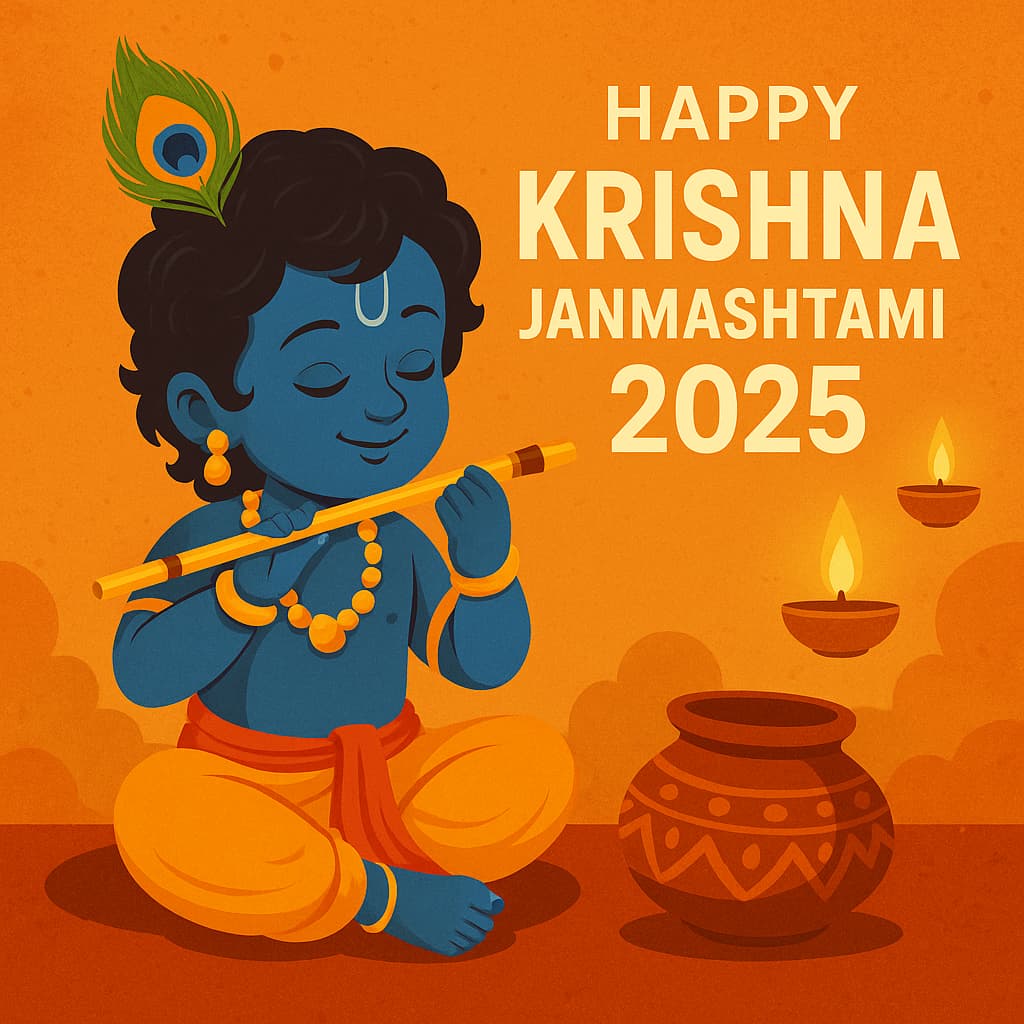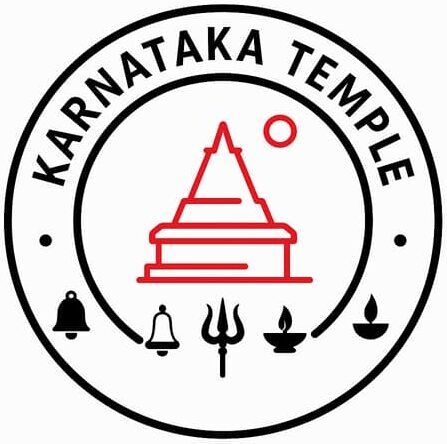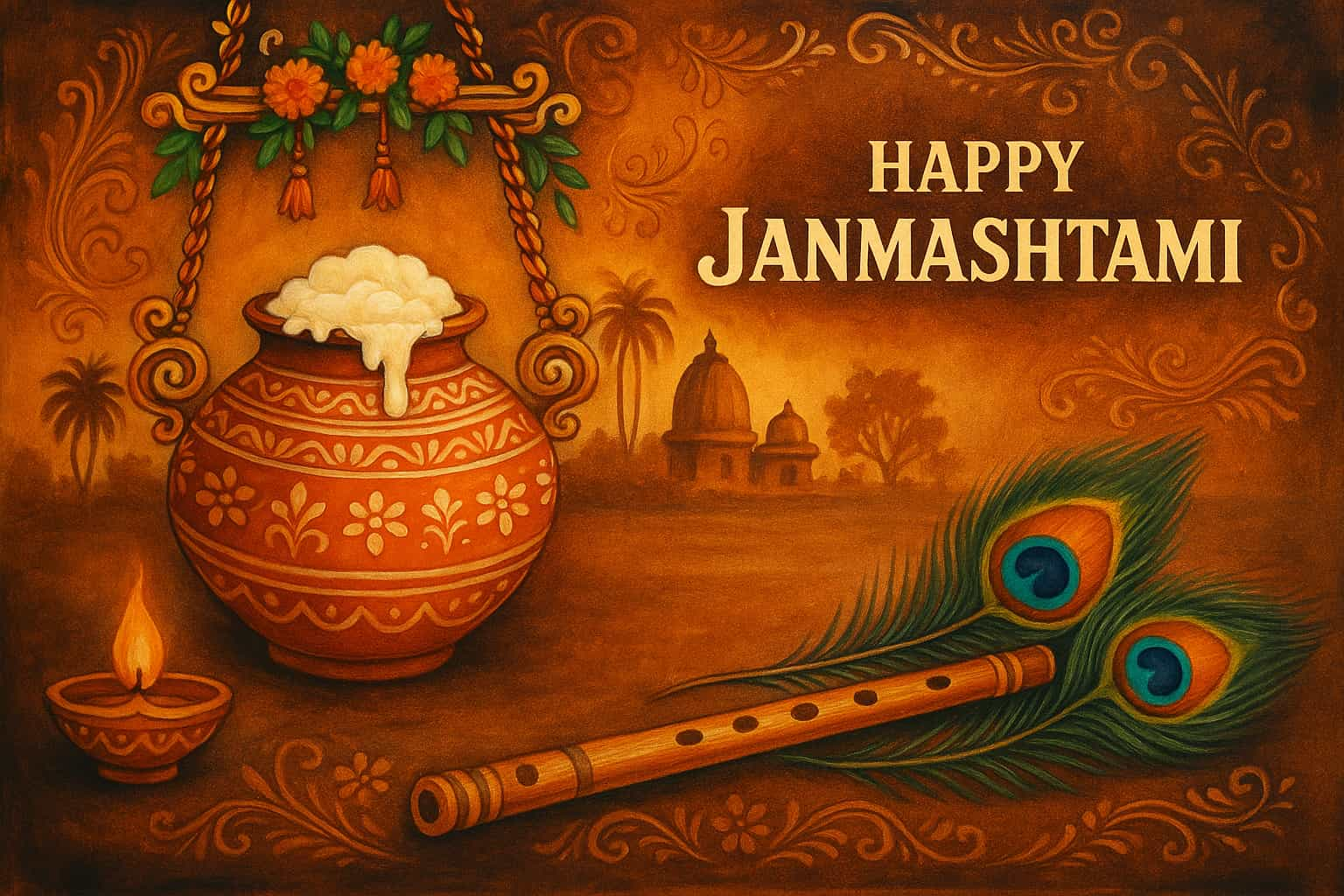Krishna Janmashtami 2025 Karnataka marks the sacred birth anniversary of Lord Krishna, observed with unmatched devotion and cultural grandeur across the state. The festival transforms temple towns and city shrines into hubs of midnight maha-ārati, continuous kirtans, elaborate abhisheka, vibrant jhulan (swing) seva, and large-scale annadāna where devotees share food as an act of service. From the intricately decorated corridors of ISKCON Bengaluru (Rajajinagar) to the centuries-old traditions at Udupi Sri Krishna Matha and the serene hilltop ambience of Melkote Cheluvanarayana Swamy Temple, every corner of Karnataka resonates with the sound of conch shells, temple bells, and joyous bhajans. In addition to these prominent centres, hundreds of local mathas and community temples join in, ensuring that Janmashtami is not just a celebration at select places, but a state-wide expression of faith, culture, and togetherness.
Year-wise Krishna Janmashtami Dates
A quick reference to upcoming Janmashtami dates over the next few years. Add this to your festival pages to help visitors plan and to capture yearly search interest.
| Year | Krishna Janmashtami Date |
|---|---|
| 2025 | 16 August 2025 |
| 2026 | 4 September 2026 |
| 2027 | 25 August 2027 |
| 2028 | 12 August 2028 |
| 2029 | 1 September 2029 |
Why Janmashtami is Celebrated
Janmashtami marks the birth of Lord Krishna, regarded in Hindu tradition as the eighth avatar of Lord Vishnu. According to sacred texts like the Bhagavata Purana, Krishna was born at midnight on the eighth day (Ashtami) of the Krishna Paksha in the month of Bhadrapada. His birth in Mathura is believed to have been a divine intervention to end the rule of his tyrannical uncle, King Kamsa, and to restore dharma (righteousness).
In Karnataka, this occasion is celebrated with unique regional traditions. The midnight timing of Krishna’s birth is honoured with maha-ārati, the offering of milk, butter, and poha—foods linked to his childhood stories—and devotional singing that continues late into the night. The festival serves not only as a remembrance of Krishna’s life and teachings but also as a celebration of values like compassion, joy, and the victory of good over evil.
Major Temples to Watch During Krishna Janmashtami 2025 in Karnataka
1) ISKCON Bengaluru (Rajajinagar) – A Full-Day Celebration
At ISKCON Bengaluru, Janmashtami starts early in the morning with special abhisheka and the offering of fresh flowers to the deities. Throughout the day, volunteers decorate the temple with fragrant jasmine garlands, mango leaf toranas, and colourful rangoli. By late afternoon, cultural programs begin—children dressed as Krishna and Radha perform dances, bhajans, and short plays based on Krishna’s childhood stories.
From 6:00 pm onward, the main temple hall and amphitheatre come alive with continuous kirtans. Visitors can join in, clap along, or simply soak in the music. Around 10:00 pm, a grand abhisheka is performed with milk, honey, ghee, and sandalwood paste, followed by the swinging of the Krishna idol (jhulan seva). As the clock nears midnight, the energy peaks—thousands gather for the midnight maha-ārati, with temple bells, conch shells, and collective singing. The celebrations conclude with annadāna, where prasad is distributed to all devotees.
2) Udupi Sri Krishna Matha – Tradition in Every Moment
In Udupi, Janmashtami is a day of deeply traditional rituals rooted in the Madhva Sampradaya. The day begins with Nirmalya Darshan (early morning darshan) and the dressing of the idol in special attire for the festival. From morning to evening, a sequence of special sevas is offered—such as Mahapooja, Panchamrita Abhisheka, and Tulasi Archana. The streets near the temple are decorated, and vendors sell flowers, sugarcane, and butter in honour of Krishna.
From evening onwards, bhakti groups gather near the Kanakana Kindi to sing bhajans. The temple’s chariot (ratha) is sometimes brought out in procession, accompanied by traditional drums and conch sounds. Volunteers move through the crowd offering sweet poha, milk, and laddus. At midnight, the Krishna idol is bathed and worshipped, followed by āratī and prasad distribution. Many devotees remain until early morning, continuing bhajans in smaller groups.
3) Melkote Cheluvanarayana Swamy Temple – A Calm yet Grand Evening
At Melkote, Janmashtami preparations begin in the morning with cleaning of the sanctum and arranging the deepa-ālankāra (lamp decorations). Priests prepare the temple for the special alankara of the deity with silk clothes and flower garlands. By sunset, the hilltop temple is lit with rows of oil lamps along the corridors and mantapas, creating a magical glow visible from afar.
Evening rituals start with Purvaranga Seva (preliminary prayers) followed by abhisheka and naivedya. Devotees participate in kirtans under the open sky, while children in traditional attire perform dance and music recitals in the mantapa. As midnight approaches, the special pooja and āratī take place inside the sanctum, after which prasad is distributed. Unlike in larger cities, here the atmosphere is more serene, giving devotees time for peaceful darshan without heavy crowds.
Other Notable Celebrations
In Mysuru, Mangaluru, Shivamogga, Hubballi–Dharwad, and Ballari, smaller Krishna temples and mathas follow similar patterns—morning abhisheka, afternoon cultural activities, evening bhajans, midnight āratī, and prasad—but on a more intimate scale. These smaller gatherings often allow more personal interaction with temple priests and community members.
Janmashtami Puja Timings Example Table
A general schedule showing common puja timings observed in many temples during Krishna Janmashtami. Actual timings can vary depending on the temple’s tradition and location.
| Puja Event | Time Range (Example) |
|---|---|
| Morning Abhisheka | 7:00 AM – 9:00 AM |
| Afternoon Bhajans | 3:00 PM – 5:00 PM |
| Evening Kirtan | 6:00 PM – 9:00 PM |
| Midnight Nishita Puja | 11:30 PM – 12:15 AM |
| Prasad Distribution | After midnight āratī |
What Usually Happens on Janmashtami Night in Karnataka Temples
Alankāra & Rangoli
By evening, temple entrances and mantapas are transformed with floral arches, tulasi garlands, and fresh mango leaf toranas. Colourful rangoli patterns line the pathways, often illuminated by neat rows of oil lamps (deepas). In larger temples, the sanctum is decorated with elaborate backdrops, fresh jasmine garlands, and shimmering fabric canopies.
Kirtans & Bhajans
As the sun sets, the sound of devotion fills the air. Rotating bhajan groups—sometimes local music schools or community choirs—take turns singing through the night. Many temples host open-mic bhakti sessions, inviting devotees to lead a song or share a Krishna story. The rhythm of mridangams and the gentle chime of kartals keep the spiritual energy alive until dawn.
Abhisheka & Special Sevas
One of the most awaited moments is the abhisheka—ceremonial bathing of the deity with milk, curd, honey, ghee, sandalwood paste, and sometimes fruit juices. The exact sequence depends on the temple’s tradition, but the atmosphere is always reverent, with chants and mantras resonating through the hall. Some temples also perform jhulan seva (placing the idol in a decorated swing) as part of the festivities.
Midnight Āratī
At exactly midnight—the believed hour of Lord Krishna’s birth—temple bells ring out, conch shells are blown, and devotees rise to their feet for the maha-āratī. Priests wave lamps before the deity while the crowd joins in congregational singing, clapping, and chanting. This is the emotional high point of the night, with an almost tangible feeling of joy and unity among the devotees.
Prasad & Annadāna
After the āratī, most temples distribute prasad—often milk-based sweets, poha preparations, or butter-themed offerings that recall Krishna’s childhood. Many larger temples also host annadāna (community meals), serving simple prasādam like rice, sambar, and sweet dishes to hundreds or even thousands of devotees.
Cultural Programs
Earlier in the evening, before the midnight rituals, many temples organise children’s fancy dress competitions where little ones are dressed as Krishna or Radha. Stages are set for classical dance performances, instrumental music, and storytelling sessions narrating Krishna’s life events. These activities not only entertain but also serve as a way to pass traditions to the next generation.
Key Rituals & Their Meanings
An overview of important Krishna Janmashtami rituals and their cultural significance.
| Ritual | Cultural Significance |
|---|---|
| Abhisheka | Bathing the deity with milk, curd, honey, and ghee to honour Krishna’s birth. |
| Jhulan Seva | Placing baby Krishna in a decorated swing, symbolising joy and celebration. |
| Midnight Āratī | Performed at the believed time of Krishna’s birth. |
| Annadāna | Offering food to devotees, reflecting Krishna’s love for feeding others. |
📅 How Krishna Janmashtami Date is Decided Each Year
The date of Krishna Janmashtami is not fixed in the Gregorian (English) calendar because it is determined by the Hindu lunar calendar. Every year, the festival is celebrated on the eighth day (Ashtami) of the Krishna Paksha (waning phase of the moon) in the month of Bhadrapada.
Two main astronomical points are considered while fixing the date:
Ashtami Tithi – The eighth lunar day, which is linked to the birth of Lord Krishna.
Rohini Nakshatra – The constellation under which Krishna is believed to have been born.
In most years, Janmashtami falls in August (sometimes late August, occasionally in early September). If the Ashtami Tithi overlaps with Rohini Nakshatra during midnight (Nishita Kaal), that night is chosen as the main celebration.
This is why the exact date can vary between regions, and why some communities celebrate Janmashtami on different days in the same year. Local temples follow their own panchanga (Hindu almanac) to decide the final observance date.
📅 Krishna Janmashtami 2025 Date & Timings
In 2025, Krishna Janmashtami will be celebrated on Saturday, 16 August 2025 in Karnataka and most other parts of India. The festival falls on the Ashtami tithi of the Krishna Paksha in the Bhadrapada month (according to the Hindu lunar calendar).
Key Timings (as per traditional panchanga for Karnataka):
Nishita (Midnight) Puja Time: 11:57 PM – 12:40 AM (17 August)
Ashtami Tithi Begins: 16 August 2025 – 02:21 AM
Ashtami Tithi Ends: 17 August 2025 – 04:10 AM
Rohini Nakshatra Time: 16 August 2025 – 01:35 PM to 17 August 2025 – 03:05 PM
Note: Timings can vary slightly depending on location and the local panchanga followed. It’s always best to confirm with your nearest temple for their exact schedule.
Celebrating Janmashtami at Home – A Simple & Respectful Outline
For those who cannot visit a temple, Krishna Janmashtami can be observed at home in a way that is heartfelt yet simple, focusing on devotion and family togetherness.
Prepare the Pooja Space
Begin by cleaning and decorating your prayer area. If possible, place a small swing (jhulan) adorned with fresh flowers and cloth, symbolising the cradle of baby Krishna. A small idol or framed picture of Krishna can be placed here for the evening’s worship.
Make Festive Offerings
Offer a variety of simple, homemade items such as fresh fruits, laddus, kheer, or poha (avalakki) preparations. These foods are linked to Krishna’s childhood stories—especially his love for butter, milk, and sweets.
Bhajans & Readings
Gather family members to sing or play Krishna bhajans. You can also read aloud a short, child-friendly story from Krishna’s leelas—his playful and divine acts. This helps younger family members connect with the cultural significance of the day.
Midnight Moment
When temples perform the midnight āratī, light a lamp at home and spend a few minutes in quiet prayer or chanting. This symbolic act connects home worshippers to the wider community of devotees celebrating at the same time.

Krishna Janmashtami 2025 Karnataka is not just a festival — it’s a night where devotion, music, lights, and community spirit come together across the state’s temples and homes. Whether you choose to experience the grandeur of ISKCON Bengaluru, the deep-rooted traditions of Udupi Sri Krishna Matha, the serene ambience of Melkote, or the intimate celebrations of your local temple, each brings its own unique charm.
From floral decorations and soulful kirtans to midnight āratī and prasad sharing, every moment of Janmashtami is filled with cultural richness and spiritual joy. Even those celebrating at home can join in the essence of the festival through simple offerings, bhajans, and a midnight prayer.
As the lamps glow and chants fill the air, Janmashtami in Karnataka reminds us of timeless values — the victory of good over evil, the beauty of devotion, and the warmth of community. Wherever you are, may this Janmashtami bring light, harmony, and blessings to your life.
🛕 Related Temple Articles
- Kali Temples in Karnataka – Discover famous temples dedicated to Goddess Kali across Karnataka.
- Temple Tips: Essential Etiquette – A guide to respectful temple visits in Karnataka.
- Ganesh Chaturthi Decoration Karnataka Style – Traditional festive decor ideas from Karnataka.

